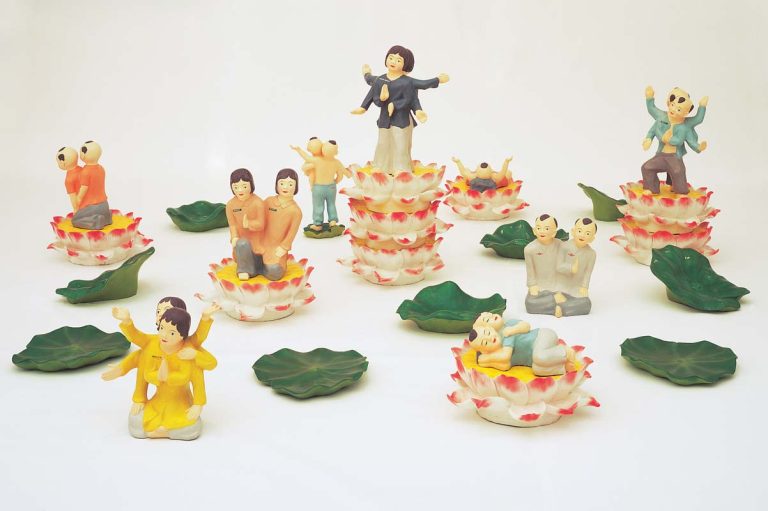We acknowledge the Traditional Owners of the land on which the Queensland Art Gallery | Gallery of Modern Art stands and recognise the creative contribution First Australians make to the art and culture of this country.

Dinh Q Lê / Vietnam b.1968 / Lotusland 1999 / Fibreglass, polymer, wood and synthetic polymer paint / 27 pieces ranging from 30 x 57.5 x 52.5cm to 77.5 x 55 x 45cm; installed dimensions variable / Purchased 2006. The Queensland Government’s Gallery of Modern Art Acquisitions Fund / Collection: Queensland Art Gallery | Gallery of Modern Art / © Dinh Q Lê
Dinh Q LêLotusland 1999
Not Currently on Display
Dinh Q Lê interweaves history, myth and popular culture to engage the legacies of war in Vietnam and the ongoing transformations in Vietnamese society. Drawing on Buddhist iconography, Lotusland depicts conjoined twins emerging from a series of lotus flowers and foliage. Though their multiple arms, legs and heads resemble those of religious deities, they symbolise the large number of Vietnamese children born with defects caused by exposure to Agent Orange and other chemical herbicides used during the United States–Vietnam War (1955—75).
Lê was inspired by his experiences visiting rural Vietnamese towns, where he found conjoined twins to be revered as ‘special spirits’ who possess the power to protect and bestow luck. Lotusland touches on the suffering and stigma of war, branding the twins’ clothing with the names of the American chemical companies responsible for producing the defoliants, but also presenting its subjects as beings to be honoured rather than shunned.
On 1 May 1975, the North Vietnamese Army marched into Saigon (now Ho Chi Minh City) signalling the reunification of the country after almost 30 years of war. Three decades after these events the complex history of violence in Vietnam continues to be framed by photojournalism and American cinema. While these images provide an intimate view of suffering, they are often limited by editing and political rhetoric. Dinh Q Lê seeks to disrupt the way these mainstream and dramatic representations have informed dominant understandings of the Vietnam–US War. Lê’s work offers an alternative perspective and experience of the Vietnamese people whose lives have been irrevocably transformed by the effects of war.
Born in 1968, Lê’s hometown of Ha-Tien on the Cambodian-Vietnamese border was invaded by the Khmer Rouge after several years of conflict.1 Fleeing with his family to Thailand in 1977, Lê remained in a refugee camp for a year before being granted asylum in the United States. Reflecting on these experiences of violence and displacement, Lê investigates the nature of identity and memory in postwar Vietnam and how the legacies of warfare are entwined with Vietnam’s ambivalent aspirations for progress. It is a strategy that allows Lê to highlight the impact of historical events on individual lives, presenting an optimistic approach to the experience of survival.
Endnotes:
1. In 1978, Vietnamese forces invaded Cambodia in response to the invasion of Ha-Tien by the Khmer Rouge, who slaughtered thousands of Vietnamese women and children. In 1979, Vietnam took Phnom Penh, forcing the Khmer Rouge to flee to the Thai border.